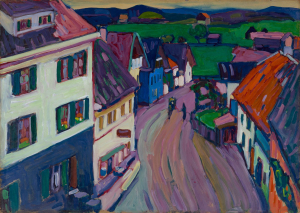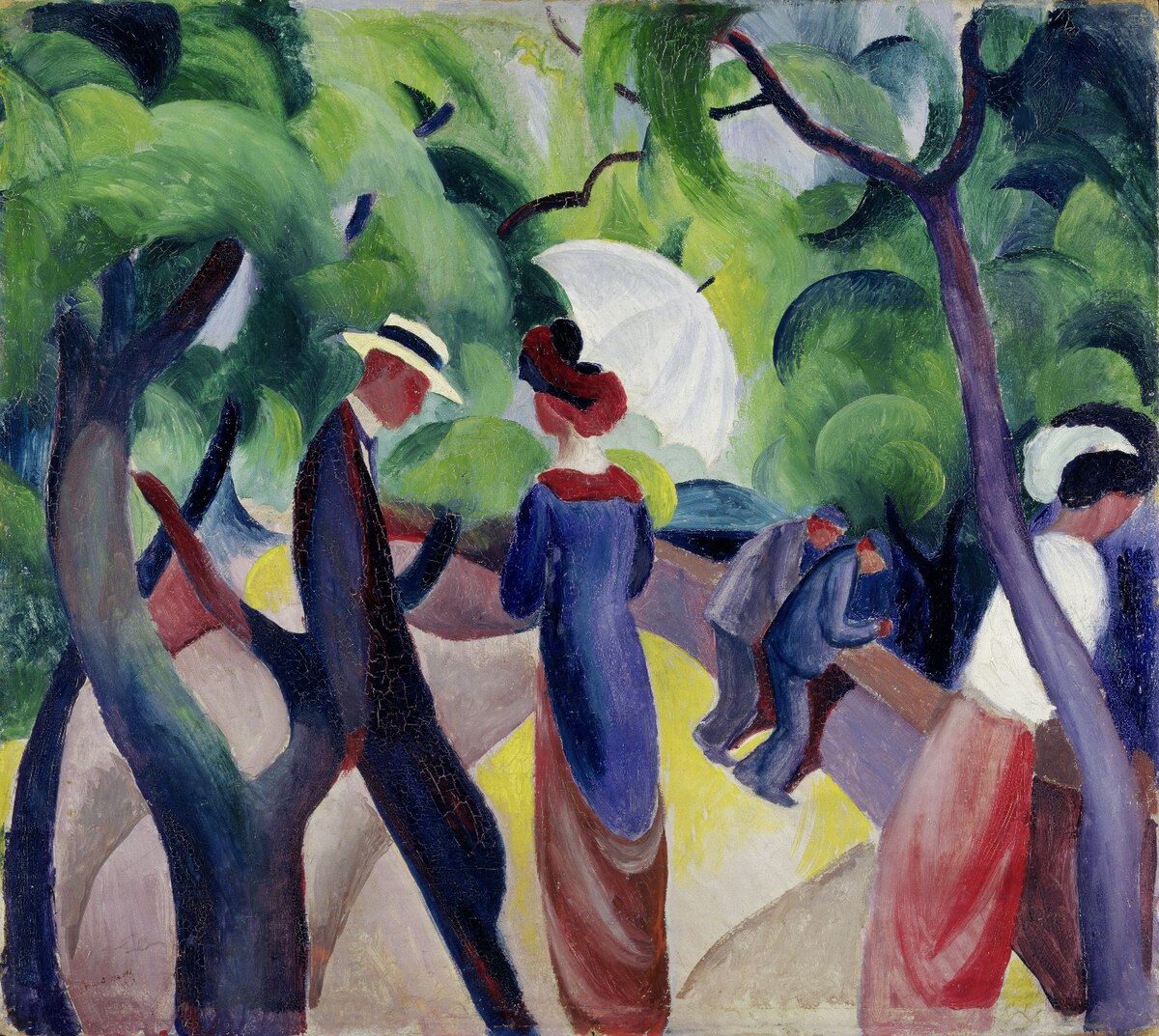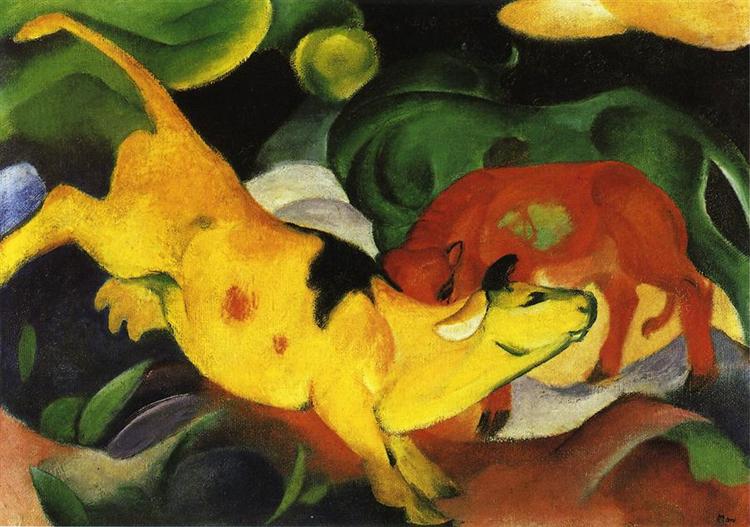
Great art exhibition, shame about the politics: 'Expressionists: Kandinsky, Münter and the Blue Rider' at Tate Modern
Nick Moss reviews Expressionists: Kandinsky, Münter and the Blue Rider, at the Tate Modern, London, to 20 October 2024. Image above: Wassily Kandinsky, Murnau – Johannisstrasse from a Window of the Griesbräu, 1908.
The first thing that should be said is that this is a vital and stunning exhibition. It is also, though, a frustrating one. The art is allowed to stand on its own terms, but the politics of the Blue Rider group and their associates are not adequately represented.
The artworks are stunning.....
To deal with the art first. The show draws on the collection of Expressionist masterpieces at the Lenbachhaus in Munich, and loans from public and private collections, including works never previously seen in the UK. Its primary focus is the works produced by the Blue Rider group (Der Blaue Reiter) and it features works by Wassily Kandinsky, Gabriele Münter, Franz Marc and Paul Klee, alongside neglected works produced by Wladimir Burliuk and Maria Franck-Marc.
The Blue Rider group did not work in isolation and their best work draws on the experiments in form and colour by Picasso and Matisse over the same period. The group, which was formed by Marc and Kandinsky in Munich in 1911, saw their art as representing a ‘spiritual awakening’. Kandinsky in particular, searching for a language of colours and shapes which would allow him to communicate more dramatically and dynamically with the viewer, moved towards a level of abstraction which served both as a symbolic language and a joyous celebration of the dance of colours and shapes as expressions of imagination. It is this that gives Expressionism its name – and it is what this exhibition brings home so brilliantly.
All too often the art on display here gets lumped into a historical mix of barely connected works, running from Kafka via Munch to the films of Murnau and Lang. But here, we grasp as we take in the wild riot of reds, yellows, blues, and greens that rush out to us that the Blue Rider Group used their work as a blazing torch to burn away the dread and alienation that scarred their times – to cut through the darkness.
It is certainly the case that the Die Brücke group, which preceded Der Blaue Reiter in pursuing the Expressionist style, channels a similar mood to that captured in films such as Nosferatu. Ernst Kirchner, for instance, in his 1908 work The Street, Dresden, evokes a sense of dread immediately recognisable from works by Schiele and Munch, with his distorted figures and contorted street furniture, premonitory to the mood of disorientation we find in, for instance, Wiene’s 1919 film The Cabinet of Dr Caligari.
However, there is little of that here. More often, the works show the influence of Henri Matisse on the group, eg his 1907 The Blue Nude, the rainbow palette of The Woman With the Hat, or the sensuous clash of psychedelic hues of his orgiastic Le Bonheur de Vivre. “What counts most with colours are relationships”, Matisse said, and unleashed the imagination of Der Blaue Reiter and painting as an attempt to capture pure feeling, and thereby resist the grey drag and grind of pre-war bourgeois European society.

If we look for instance at August Macke's 1913 Promenade (above), the two male figures are thrown on a lurching carpet of browns and yellows to the balcony edge, and the central couple, elongated, lugubrious, are caught up in swirls of green, with an umbrella glowing white like a half-moon. And maybe we’re already seeing the essence of what Der Blaue Reiter represented.
Most people can paint the moon if they’ve seen it – but to paint an umbrella that’s a half-moon in a way that’s instantly recognisable as both at the same time is the essence of what Macke, Kandinsky and their comrades sought to do. As Kandinsky put it:
'Not everything is visible and tangible; or – to be more explicit – under the visible and comprehensible lies the invisible and incomprehensible.'
For the Expressionists, the point was to make the incomprehensible graspable again, but through a language of colour and shape, and instinctively. The aspect of Expressionism that stands out most vividly here, though, is joy – and joy as a kind of sensory overload. Marc's 1912 Tiger is an assemblage of blocks of colour that show us the coiled, tensely muscled animal with a watchful yellow eye. Marc had a deep interest in Buddhism and a consequent fascination with animism – other artists in the group followed the esoteric teachings of the Theosophical Society, mixing European occult traditions with appropriated elements of Hinduism, Buddhism, ancient Greek philosophy and modern science.

Marc's fascination with animism gives us his stunning, playful Cows – Red, Green, Yellow (1911, above) which combines love of colour with celebration of simple bovine joie de vivre. It also carried a grim portent of its era. By 1913, his empathic engagement with animal esprit had turned to a painterly agony – the butchery of all life forms in his stark, blood-red The Fate of the Animals, on the back of which he scrawled ‘and all being is flaming suffering.’
Expressionism is a movement which existed within an interregnum, between the second Moroccan crisis and the outbreak of the First World War. It was a time of horrors brought about by the clash of imperialisms, nationalisms and feudal aristocracies from 1914 onwards, and Expressionism treated painting as a way of holding on to a belief in something better. It stood for beauty, as against death. We can see this in works such as Kandinsky's extraordinary Riding Couple 1906/07 – the sheer romance of it, the night chill, the shimmer of lights on water. And Kandinsky was always on the verge of abstraction, wanting to dispense with painting as illusion in favour of paint as language, freed to be itself.
The real revelation here is in the works displayed by Gabriele Münter. The importance of the Blue Rider group and its earlier participation in the formation of the NKVM (New Artists’ Association of Munich) was partly that it encouraged (and the association admitted) women artists such as Marianne Werefkin and Elisabeth Epstein, enabling them to exhibit and sell their work.

Münter, though, emerges as a key figure in the group. We see the photographs she took in Tunisia in 1904-5, on a trip with Kandinsky, and the experiments in reverse glass painting, after the groups' relocation to Murnau. We have her 1912 painting of Kandinsky and Erma Bossi at the Table (above), which captures them at ease, as equals, in discussion, and we have her 1909 Murnau Farmer's Wife with Children , which is more than anything a portrait of poverty and unease. It shows that Münter was fully aware that what was a rural idyll for the group was no paradise for the Murnau peasantry.
Münter, just as much as Kandinsky, appears as the driving force of the group. Similarly, on show is Werefkin's 1909 The Dancer. Werefkin stated: “I am not a man, I am not a woman, I am I.” The painting of the androgynous dancer/performer Alexander Sacharoff, then, is a gesture of solidarity mapped out in large brush strokes of deep blue.
Ultimately, though, it is Kandinsky who sets the pace, who pushes the painting of light and colour to the point of a magnificent abstraction. Kandinsky’s Impression III (Concert) and his Improvisations are attempts at synaesthesia as art form – colour as musical note. Ultimately though, they are colour as defiance in the face of war.
...but it's not so good on the politics
It is at the level of politics, though, that the exhibition falls short of the aims it sets itself. The Blue Rider Almanac draft preface is quoted:
‘In our case the principle of internationalism is the only one possible … The whole work, called art, knows no borders or nations, only humanity.’
We are told that:
‘the transnational network of contacts and affiliations included artists with similar experiences of migration or displacement, as well as those seeking new approaches towards spirituality and artistic expression.’
We are then also told:
‘At the same time, the artists experienced Bavarian society as it integrated into the German Empire. Founded in 1871, the empire quickly developed into the world's third largest economy. The government pursued imperial and colonial ambitions including the exploitation of people and resources overseas. Public fascination with world cultures was underpinned by racist narratives and cultural and ethnic hierarchies of imperialism. These biases are visible in the display of cultural objects from colonial territories, in particular those collected anonymously and attributed to unknown artists.’
It is unclear how both statements can be true. How is the internationalist collective of the displaced to be at one and the same time carriers of the biases of their time, except in the most banal sense in which all of us have to battle against the doxas of our age in order to maintain a critical consciousness?
What is at work here is a kind of revisionist fear – all work produced within the culture of Western Europe has to be qualified by reference to the prejudices of that general culture –even when it has been produced in opposition to it. The danger of this is that effective oppositions within the arts (and within revolutionary movements more widely) get airbrushed out, treated generically as part of the culture they opposed and thereby lost as a resource for us.
Far from treating the works and their specific culture within and against the historic developments of their time, we end up with ahistorical judgements which fail to adequately recognise the politics of critical and theoretical movements of the past. Thus, re the Blue Rider Almanac: the almanac featured:
‘tribal art from the Pacific Northwest, Oceania and Africa, the art of children, Egyptian puppets, Japanese masks and prints, medieval German sculpture and woodcuts, Russian folk art, and Bavarian devotional paintings.’
- Foster/Krauss/Du Bois/Buchloh: Art Since 1900, p. 85
As such, it was intended as a celebration of a universal folk art – about as far from the racist narratives of the ‘cultural and ethnic hierarchies of imperialism’ as the group could get. It was in fact produced to undermine exactly those hierarchies.
It is impossible to fully understand the Blue Rider group without seeing it as a project which stood explicitly against the spirit of its age. As Benjamin Buchloh says:
‘...in the early part of the twentieth century, some of the major figures of the historical avant-gardes had aligned themselves with strong articulations of internationalist Utopian thought...In other cases, when abstraction was not explicitly associated with the universalism of socialist politics (the work of Kandinsky or Klee for example) it wanted to be at least aligned with the universal enlightenment and progress of science and technology or...it wanted to be linked with a spiritual Esperanto and secularised forms of transcendental thought.’
- Benjamin Buchloh, Neo-Avant Garde and Culture Industry, 2003, p. 307.
The Blue Rider painting by Marc, and its reworking by Kandinsky for the Almanac cover, substantiate this – the rider as symbol meant, for Marc and Kandinsky, the ability to move beyond, to surpass, to overcome.
Moreover, not only did the group itself function as an avant-garde collective, committed to experimenting with new forms of art and living, but it actively sought out others with similar commitments to challenging the norms and hierarchies of the pre-World War 1 era. It particularly sought out the group around Herwarth Walden's Der Sturm magazine, where the Blue Rider group worked and exhibited alongside others such as Sonia Delauney, Oscar Kokoschka and August Macke, and also alongside writers such as Karl Kraus and Alfred Doblin and where the ideas of the Expressionists were presented alongside those of the Dada-ists and Surrealists.
This is a stunning exhibition. However, when Blue Rider artists like Franz Marc said in 1914 that "renewal must not be merely formal but a rebirth of thinking”, we should remember they were not celebrating the culture of their times. They were relentlessly opposed to it and calling for a renewal of a society that was otherwise about to hurl itself into a four-year quagmire of trench warfare, poison gas and famine.
